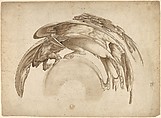Soldier on Horseback in Catoptric Anamorphosis (after Hendrick Goltzius)
Jean François Niceron French
After Hendrick Goltzius Netherlandish
Not on view
At plain sight, this large, complex design of fan-shaped form, with a semicircular edge at center, is teasingly indecipherable. Recently discovered, it is in fact a fascinating and extremely rare representation of a virtuosic exercise in catoptric anamorphosis. The undistorted visual source for the image is Titus Manlius, an engraving from the series The Roman Heroes by Hendrick Goltzius (see the two impressions in the Metropolitan Museum of Art nos. 49.97.694 and 51.501.39).
The present drawing is modeled in a luminous pictorial technique with brush and washes on a single, very large sheet of thick laid paper. The pen-and-ink outlines are, in some passages, jittery, indicating that the artist was rethinking the original and working carefully as he drew the distorted design. He almost certainly relied on a reflection in a mirror as a shortcut to create the optical illusion, rather than constructing every line according to the geometry of a perspectival projection. The number of changes in the preliminary underdrawing in leadpoint or grayish black chalk, with respect to the final outlines in pen and ink, show this to have been a profoundly creative drawing.
This image cannot be enlarged, viewed at full screen, or downloaded.



